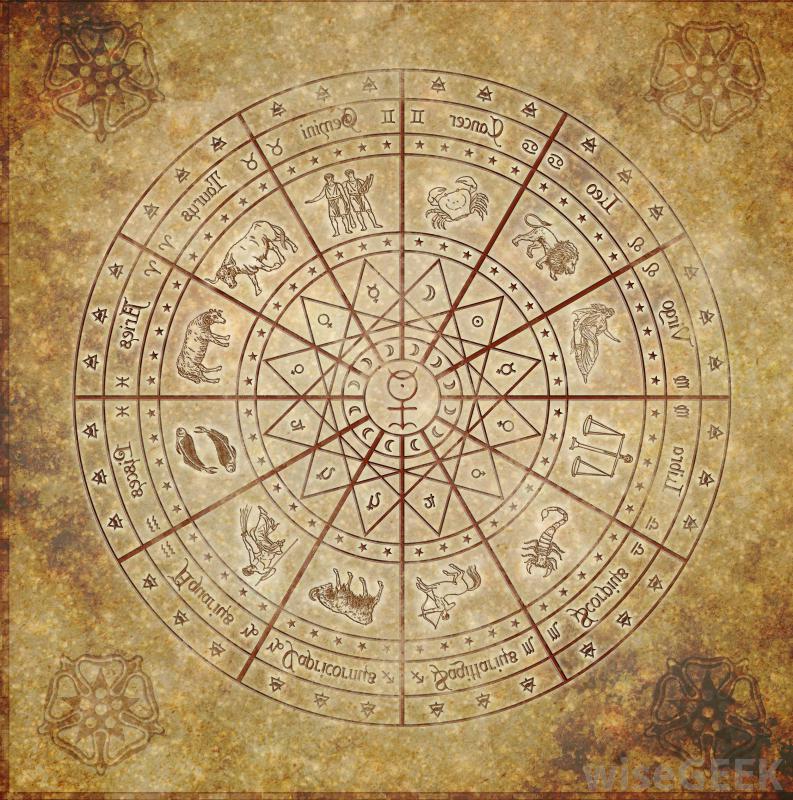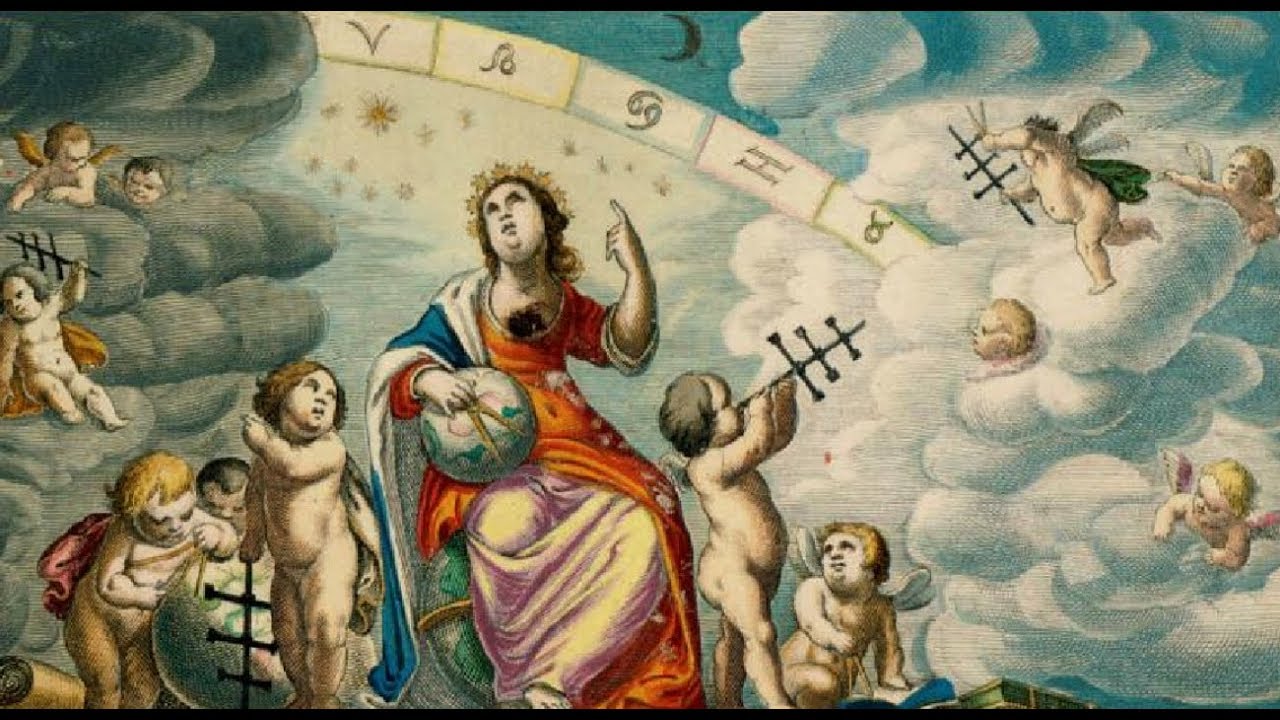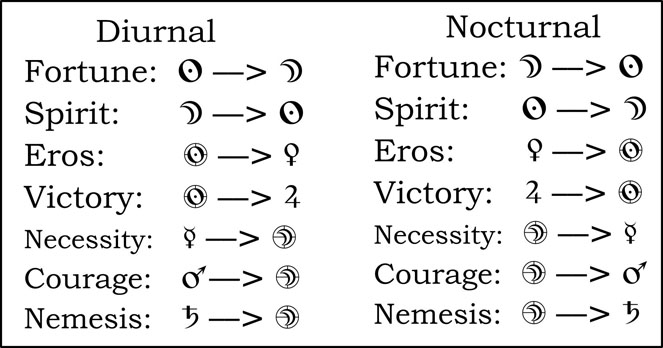In the first part of this paper on Arabic lots, we have dealt primarily with their definition, role in the natal chart, and the concept behind these, perhaps even the most mystical, astrological factors. The topic of this section will be the four principal and most important Arabic lots in the natal chart according to Valens, namely Fortuna, Spirit, Eros, and Necessity.
First, let us consider the nature of the lots of Fortune and Spirit, as the two most important Arabic lots in the horoscope, which is evident from their calculation that includes both luminaries, the Sun and the Moon, and their relationship of “light and darkness” projected from the ascendant. If we know that luminaries and Asc are three of the four most important points in the horoscope (with MC), the importance of the said lots seems obvious.
Fortuna is the life quality of the soul, its earthly happiness and comfort, the gains and losses of life. Valens calls it an archetypal point (archetypal kleron). Both Valens and Dorotheus refer to Fortuna as a point to turn to if the triplicity rulers of the dominant luminary at the time of birth are poorly placed, emphasizing that if Fortuna and her ruler are well placed, despite the poor placement of triplicity rulers, the native will have joy and success in life, as the result of happy circumstances. As mentioned earlier, this lot is more concerned with matter and material acquisition, so it is one of the more important factors in assessing the financial and property opportunities of the native. As it is a lot of the Moon, it is more related to the lower psychic aspects, the material attachment of the soul to life. The Moon is the closest body to the sublunar sphere of bodily life and hence the Moon’s connection with the body and gluttony. Her virtue is hope that relates to the capacity of the soul to rise above the weight and scarcity of life. It is a reflection of the potential to survive even in the worst temptations of life with a preserved hope that more and better can be achieved. Gluttony is her sin. It refers to the “pollution” of the soul by earthly appetites and cravings. When Lot of Fortune is emphasized in the chart, it is indicative of great passions that are hard to satisfy, the desire for wealth, etc.
It is sometimes used as an alternative ascendant, so according to Valens, houses derived from Fortune are viewed similarly to those designated by the ascendant, although it can be said that they are more related to accidents that befall the native, his circumstances, and bodily issues. Valens particularly emphasizes the eighth sign from Fortune as a place that provides insights about the qualities of death. He finds these indications so important that they occupy a very important place in his chart examples of violent deaths. He also focuses on the eleventh sign from Lot of Fortune, which he calls the “place of acquisition”, highlighting the potential of that place to bring assets and goods when well placed, that is, when benefics are placed or configured with that sign. He also views the domicile ruler of this lot in a similar way to the ruler of the ascendant, so that the sign where this planet is placed would give important indications about the main topics in life.
The Spirit, Agathos daimon, pars futurorum or ta’alima as it is known in Hebrew, is the point of the divine spirit, the point of mystery and prophecy, often in itself a significator of the soul. It is related to the personal understanding and experience of God. Her virtue is Faith, and the very word says that it refers to the religious affinities of the incarnated soul. When emphasized in the chart it is indicative of the fairness and devotion of the soul. This is the lot of the right path to God and the lot of the highest spiritual aspirations. The spiritual aspect of the soul is faced towards the return to the timeless realms. The most important of the seven lots.
Her sin is pride, especially when poorly integrated. In Christianity, it is the original sin that preceded the fall of angels. This is, according to some authors, the most important of all lots because it is a symbol of a timeless spirit. We find it prominent in the charts of people with higher spiritual aspirations, most usually placed on Asc, MC, or in close aspect with the Sun or Moon, or their own dispositor or with the ruler of the ninth house. This lot, alongside its dispositor, is a symbol of the strength of the soul, its motivation, and its mobility. Being poorly positioned in XII, VIII, VI house or even in II house without aspect with any luminary or their dispositor, it indicates a weakness of faith, especially if Fortuna is more prominent and stronger, when it is regarded as a sign of an over-attachment of the soul to matter and time, but also it can signify atheism or the rebellious mind.
In medieval astrology, it had a similar significance, so Bonati states that this lot refers to God or relationship to God as well as secrets, and therefore it is associated with the natives’ concept of God or his highest spiritual concept, so its significance is enormous, especially in spiritual counseling because we want to know what is most valuable to the person in question. The approach to spirituality is thus also interpreted from the position of this lot in signs of different elements. So, when placed in air signs the native will value knowledge the most and will have a more intellectual approach to the matter, while the water signs will have more of a devotional approach, the fire will express it through their activities, philanthropy, and creativity, while the earth signs will be most focused on practical profits. The position of the ruler of the point will indicate the areas of life in which this urge will manifest most naturally. Also, this point can be used as an alternative ascendant, so from such horoscope, we could interpret the spiritual potential and concept of the native.

Valens has a different calculation method for the lots of Eros and Necessity then the one presented when seven hermetic lots were discussed
According to Valens, the lot of Eros is calculated by projecting the distance from the lot of Fortune to the lot of Spirit from the ascendant, reversed for night births. Valens says that Eros signifies desire (epithumia).
„The Lot of Love transmitting or receiving in operative signs, with benefics in conjunction or aspect, brings about moral desires and makes men lovers of the good: some turn to education and physical or artistic training; they are softened by their delight in their hopes and they do not consider their forethought/goal a matter of difficulty. Others are enchanted by love and intimacy with men and women, and they consider to be good.“ (Valens: Anthologies, Book IV, pg. 90)
From the above quote, we can see that Valens relates this lot to moral qualities and intellectual aspirations, but also sensuality, so in some nativities, Eros seems to be focused on the mind, while in others on the more physical level. From this point of view, we can conclude (in the context of other VE factors of the horoscope) how happy a person is in love, how much he is loved, how capable he is to love, how moral he is, and in what manner does he pursue good and spiritual issues. Like all lots it should be placed in a good house, a sign ruled by benefic, activated by close aspects from rulers, benefits, or luminaries. This lot is also called the philosopher’s lot by some interpreters. Hephaestion adds that Dorotheus describes how this lot is used by some astrologers in discussing the issue of friendship (philias), so he includes it in connection with this topic in his Apotelesmatics.
The Lot of Necessity is calculated oppositely. So, in day births it is found by determining the distance from the Lot of Spirit to the Lot of Fortune, then counting that distance from the Ascendant; for night births, the reverse method is used. Concerning the considerations in Part One, it is evident that the calculation method also has an underlying symbolic and philosophic background in the discussion of the ruling luminary, especially if we regard the lot of Spirit as the lot of the Sun and Fortune as the lot of the Moon. With the Lot of Eros, we were also able to observe the movement from the luminary outside the sect – the Moon, towards the ruling one, the Sun.
Valens states that this lot indicates enemies (echthron). She seems to describe the nature and circumstances that accompany conflict and competition so that when the malefics are associated with it, it will bring failures and attacks, while when associated with the benefics it speaks of victory and that the native will overcome all temptations. So, Valens writes:
„The Lot of Necessity transmitting or receiving in operative signs, with benefics in conjunction or aspect, brings family ties, associations with the great, and the downfall or deaths of enemies. If malefics are in conjunction, it brings lawsuits, judgments, and expenses. As a result, men fail in their goals and live miserably. If the configuration is afflicted, men are condemned or ruined.“
It should be also noted that there are also special prognostic techniques that are based on these lots, which indicate the most important periods in life about the issues to which they relate. One is Aphesis, or zodiacal releasing technique, which can be calculated from the lot of Fortune for health and body issues, from the lot of Spirit for the most important periods in terms of career and reputation in the world, but also the lot of Love (Eros) has proven effective for matters of love and marriage. Also, Benjamin Dykes concludes that the transits of Saturn through the lots of Fortune and Spirit represent the most sensitive periods of life. A similar conclusion can be drawn for the other two lots that were described here.
So there we have it, an overview of the most important Arabic lots, which provides a somewhat more esoteric insight into the natal chart and the potentials of the incarnated soul in worldly life. Through them we can gain insight into the spiritual nature of the native, which is further expressed through the most important ethical principles that are complementary to the temperamental personality structure discussed earlier, thus somehow completing that weave of the Universe manifested through the unique physis of the native that is painted with symbolic astrological language through the natal chart.
- Chris Brennan – Hellenistic Astrology: The study of Fate and Fortune
- Chris Brennan – The Theoretical Rationale Underlying the Seven Hermetic Lots
- Robert Zoller – Arabic parts in Medieval Astrology (a lesson from DMA course)
- Nataša Karalić Koprivica – traditional astrology blog link


